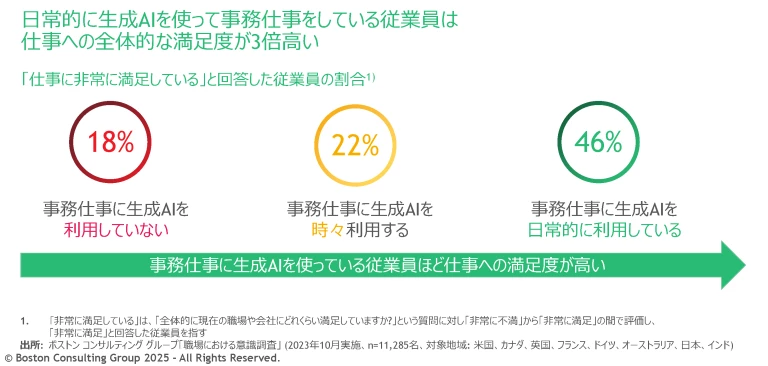従業員の離職リスクは、すべての経営リーダーが注視すべき課題だ。BCGヘンダーソン研究所(BHI)が世界の1,000人のオフィスワーカーを対象に実施した調査によると、ほぼ半数のオフィスワーカー(45%)が、必ずしも積極的ではないにしろ、転職を視野に入れている。この割合は、25~34歳の若年層で51%、人種的・民族的マイノリティ層では54%に上昇する。すべての業界・職種に離職リスクはあるが、 旅行・観光 (71%)、法務(70%)、食品・飲料(67%)、消費財(67%)などの領域で特に高い。
経営リーダーのほとんどは、従業員が自分の仕事を「おもしろい」「やりがいがある」「楽しい」と感じているかどうかを、深く(または戦略的に)考えていない。
もちろん、従業員の離職を減らし定着を促進することは、それぞれの企業に特有の背景がある複雑な問題だ。しかし喜ばしいことに、今回の調査はすべての企業に共通する解決策も提示している。それは「従業員の喜びを重視すること」だ。これは直感的には理解しやすいが、これまで生産性や離職率低減・人材定着の議論においては軽視されてきた。実際、多くの企業が従業員の 健康やウェルビーイング に気を配るようになってきているものの、仕事そのものには目を向けずに、福利厚生の改善によりこれらの課題に対処しようとすることが多い。経営リーダーのほとんどは、従業員が自分の仕事を「おもしろい」「やりがいがある」「楽しい」と感じているかどうかを、深く(または戦略的に)考えていない。これは、重要な人材の流出につながる盲点となり得る。
仕事の楽しさが離職率を半減させる
「仕事を楽しんでいる社員」は、そうでない社員に比べて転職を検討する可能性が49%低い
私たちは、従業員が自分の仕事で感じる楽しさや、自分の力を発揮できているという実感がもたらす影響について理解するために「Making Work Work」調査を設計した。調査の結果、喜びの実感が従業員の保持に非常に大きな影響を与えることがわかった。「仕事を楽しんでいる社員」は、そうでない社員に比べて転職を検討する可能性が49%低かったのだ。これは BCGが別途実施した1万1,000人超を対象とした調査 の結果とも一致している。その調査では、1年後の定着率との相関において「楽しいと思える仕事をしている」ことが3番目に強い要因であるとされた。これは「雇用が安定している」や「職場で尊重されていると感じる」に次ぐ要因となっている。
「Making Work Work」調査によると、一般社員は仕事の楽しさを評価するスコアが最も低く、離職リスクが最も高い。100点満点で「誰よりも仕事を楽しんでいる」状態を100、「仕事をまったく楽しんでいない」状態を0としたとき、一般社員の仕事の楽しさの平均スコアは55である一方、経営層では76だった。
興味深いのは、喜びと定着率の関係が、仕事であまり力を発揮できていないと感じている従業員にも当てはまることだ。調査に回答した一般社員の約4分の1は「仕事は楽しいが、力を発揮できていない」と自分を評価しており、このグループの離職率は「仕事が楽しく、力を発揮できている」と感じている一般社員(35%)とほぼ同じ低い水準(38%)であった。さらに詳しく調べると、これらの「仕事は楽しいが、力を発揮できていない」従業員の60%は、テクノロジー、金融サービス、専門サービスに従事しており、他の業界の従業員に比べてやや若く、勤続年数も短い傾向があることがわかった。彼らの自己評価は、仕事に対する習熟度が不十分であることに起因している可能性がある。実際、このグループの定性的な回答の約10%が、自分の力を発揮できていない要因として「新しい仕事に慣れていないこと」や「トレーニングが足りていないこと」を挙げている。
解は「ハイブリッド」のワークモデルに
調査では、チーム主導型のハイブリッドワークモデル(チーム単位で出社やリモートでの業務スケジュールを決めるやり方)が、事務作業、集中作業、共同作業など、多岐にわたる活動において、最も大きな喜びと、力を発揮できているという感覚をもたらすことがわかった。
ところが、多くの企業がハイブリッドワークモデルを採用しているように見えるものの(回答者の58%がそう答えた)、チーム主導で働き方を決定できていると答えた回答者は、全体のわずか13%にとどまっている。一方で、59%の回答者が上層部からの指示によって働き方を決められているという。これは見直しの余地があるだろう。というのも、チーム主導のモデルでは、トップダウンのモデルに比べて、従業員の喜びが13%上回るのだ。
重視すべきは、チーム主導のハイブリッドワークモデルを採用している企業は、主要ビジネス指標においても同業他社より優れたパフォーマンスを発揮していることだ。2024年初めに、Scoopの「Flex Index」から得られたワークモデルポリシーと企業の売上データを分析した結果、ハイブリッドワークモデルを採用している企業(従業員が一部の日にリモートで働くことを許可し、他の日にはオフィスに出勤することを求める企業)は、従業員に常にオフィスで働くことを求める企業と比べ、2020年から2022年にかけて2倍のスピードで成長を遂げたことが明らかになった。
喜びを高めるには現実を具体的に把握することが必要
私たちが以前に実施した調査では、 従業員がどんな種類の業務にどれだけ時間を使っているか を明らかにした。例えば、一般社員は平均約3分の1(37%)の時間を、複数人での共同作業など、対面で最も効果的に行えると考える仕事に費やしていることがわかった。対して、管理職や経営層は、新規採用者のオンボーディングやフィードバックの提供など、対面で最も効果的と考える仕事にほぼ半分(49%)の時間を費やしていた。私たちはさらに、働き手がこれらの業務にどれだけ喜びを感じているかを示す分析を重ね合わせることができた。その結果、多くの従業員が喜びを損なう業務に時間を費やしすぎていることが判明した。
この傾向は特に一般社員に当てはまり、彼らはたった5%の時間しか喜びの大きい仕事をしていない。一方、管理職や経営層は56%の時間を喜びの大きい仕事に費やしている。特に顕著な一例を挙げると、一般社員は業務時間の29%を事務仕事に充てているが、これにはほとんど喜びを感じていない。一方で、能力開発にはわずか5%の時間しか費やしていないものの、大きな喜びを感じている。対して管理職や経営層は業務時間の約5分の1(19%)を対話型の仕事に充てており、一貫して喜びを感じていることがわかった。
楽しめる職場をつくるには
これらの調査結果は、仕事の進め方を再考する取り組みに役立つはずだ。例えば、企業は従業員の多くが回答している事務仕事の量をふまえ、 生成AI などの技術を活用してこの種の作業を自動化し、より喜びを感じられる業務に時間を割けるようにすることを検討すべきだ。
経営リーダーは本腰を入れて、従業員が仕事を楽しむことを妨げている要因を特定しなくてはならない。
これは、企業が生成AIを業務プロセスに組み込むことに注力している現状を考えると、特に重要だ。このような取り組みは、主に生産性や創造性の向上が目的になっているが、企業は生成AIで従業員の喜びを高める可能性も探る必要がある。BCGが1万1,000人の従業員を対象に別途実施した 初期的調査 でも、有望と思われる結果が出ている。事務作業のためにChatGPTを日常的に使用している人の中では「仕事に対して非常に満足している」と回答した割合が46%にのぼった一方、事務作業に生成AIツールを使用していない人では18%にとどまった。
また、経営リーダーは本腰を入れて、従業員が仕事を楽しむことを妨げている要因を特定しなくてはならない。「Making Work Work」調査では、従業員の喜びと職場への定着には共通する二大要因があることが明らかになった。それは「モチベーション」と「サポート」である。経営リーダーは、従業員のニーズをより深く(顧客に対する理解と同程度の深さで)理解してはじめて、離職リスクの高い状況を一変させるようなプログラムや方針を設計できる。何を喜びと感じるかは、人によって異なるのだ。
ほとんどの企業が仕事や 働き方 を再形成している今日、企業が従業員にとっての喜びの重要性を認識することは必要不可欠だ。優秀な人材を引きつけ、定着させられるかどうかは、それにかかっている。
The authors wish to thank Jacob Smith, Jessica Lao, Caitlin Arnold, and Sophia He for their contributions to this article.
原典: Enjoying Work Matters More Than You May Realize












